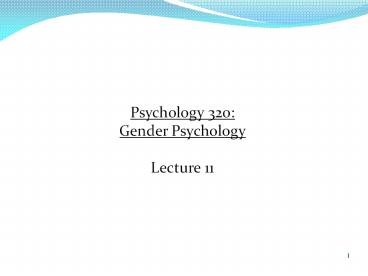Psychology 320: Gender Psychology Lecture 11 - PowerPoint PPT Presentation
1 / 19
Title:
Psychology 320: Gender Psychology Lecture 11
Description:
Gender Psychology Lecture 11 Scoring Your Questionnaire: AMI Compute the following averages: Score 1: Add your scores on items 2, 4, 6, 8, 9, 11, 14, 15, 17, 19. – PowerPoint PPT presentation
Number of Views:115
Avg rating:3.0/5.0
Title: Psychology 320: Gender Psychology Lecture 11
1
Psychology 320 Gender PsychologyLecture 11
2
Scoring Your Questionnaire AMI
- Compute the following averages
- Score 1 Add your scores on items 2, 4, 6, 8, 9,
11, 14, 15, 17, 19. Divide total by 10. - Score 2 Add your scores on items 1, 3, 5, 7,
10, 12, 13, 16, 18, 20. Divide your total by 10.
3
Sex Stereotypes
1. What features characterize female and male
stereotypes? (continued)
2. Are there subtypes of sex stereotypes?
3. What are the consequences of sex stereotypes?
4
By the end of todays class, you should be able
to
1. summarize the results of research on the
characteristics of sex stereotypes.
2. discuss the function of sex stereotype
subtypes.
3. list the stereotype subtypes for females and
males.
5
4. define the terms traditional sexism and
modern sexism.
5. describe contemporary measures of traditional
sexism and modern sexism.
6
What features characterize female and male
stereotypes? (continued)
- Williams and Best (1990, 1999) replicated
Broverman et al.s findings across 30 countries.
- Recruited male and female participants from
diverse countries (e.g., Austria, Bolivia,
Ireland, Italy, Japan, Peru, New Zealand,
Nigeria, the Unites States).
7
- Presented participants with 300 characteristics
and asked them to indicate which items were more
characteristic of men and which items were more
characteristic of women.
8
- Defined a stereotypical characteristic as one
for which
1. two-thirds of both females and males within a
country agreed that the characteristic described
one sex more than the other (indicating
consensus within that country for the
characteristic).
2. three-quarters of the countries surveyed
agreed that the characteristic described one sex
more than the other (indicating cross-cultural
consensus for the characteristic).
9
Characteristics Consensually Associated with Men
Dominant Self-confident Boastful Adventurous Asse
rtive Unkind Strong Energetic Opportunistic Aggres
sive Coarse Logical Forceful Clear-thinking Invent
ive Independent Active Robust Unemotional Stern Pr
ogressive Wise Courageous Daring Ambitious Rationa
l Hardhearted Determined Disorderly Realistic
10
Characteristics Consensually Associated with Women
Charming Fearful Weak Sensitive Gentle Curious Emo
tional Mild Sexy Shy Pleasant Talkative Anxious Su
bmissive Affectionate Attractive Dependent Affecte
d Meek Kind Softhearted Sentimental Superstitious
Dreamy
11
- These lists of characteristics were examined in
an effort to identify their underlying
dimensions. Three dimensions were identified
1. Strength In general, men were viewed as
being stronger than women.
2. Activity In general, men were viewed as
being more active than women.
3. Positivity In general, men were viewed more
positively than women.
12
Are there subtypes of sex stereotypes?
- Researchers (e.g., DeWall et al., 2005
Edwards, 1992 Six Eckes, 1991) have
identified a number of stereotype subtypes for
females and males.
- Stereotype subtypes allow individuals to
categorize unusual cases as exceptions and,
thus, maintain general sex stereotypes.
13
- Six and Eckes (1991) identified 3 female and 5
male subtypes
Female subtypes
- The traditional subtype Maternal, devout,
naïve, conforming, dependent.
- The progressive subtype Intellectual,
ambitious, confident, liberated, independent.
- The sex bomb subtype Attractive, seductive,
flirtatious.
14
Male subtypes
- The career-oriented subtype Intellectual,
ambitious, confident, social climbers.
- The playboy subtype Cool, casual, macho, lady
killers.
- The sensitive subtype Quiet, philanthropic,
softies.
- The bureaucratic subtype Conservative,
conventional, ordinary, common, boring.
- The egotist subtype Egotistical, selfish,
conceited.
15
What are the consequences of sex stereotypes?
1. Sexism
- Refers to the positive or negative affective
reaction that people have toward others because
of their sex.
- Four forms of sexism toward women have been
identified Traditional sexism (TS), modern
sexism (MS), hostile sexism (HS), and benevolent
sexism (BS).
16
- TS and MS are assessed by the Modern Sexism
Scale (MSS Swim et al., 1995).
17
Items from the MSS (Swim et al., 1995)
Traditional Sexism Women are generally not as
smart as men. (R)I would be equally comfortable
having a woman as a boss as a man.It is more
important to encourage boys than to encourage
girls to participate in athletic activities. (R)
Women are just as capable of thinking logically
as men.When both parents are employed and their
child gets sick at school, the school should call
the mother rather than the father. (R)
Modern Sexism A. Antagonism Toward Womens
DemandsIt is easy to understand the anger of
womens groups in America.It is easy to
understand why womens groups are still concerned
about societal limitations of womens
opportunities.
18
Modern Sexism, continuedB. Denial of
Continuing Discrimination Discrimination against
women is no longer a problem in the United
States. (R) Women often miss out on good jobs
due to sexual discrimination.It is rare to see
women treated in a sexist manner on television.
(R) On average, people in our society treat
husbands and wives equally. (R) Society has
reached a point where women and men have equal
opportunities for achievement. (R)C. Resentment
About Special Favors for WomenOver the past few
years, the government and news media have been
showing more concern about the treatment of women
than is warranted by womens actual experiences.
(R)
19
Sex Stereotypes
1. What features characterize female and male
stereotypes? (continued)
2. Are there subtypes of sex stereotypes?
3. What are the consequences of sex stereotypes?































